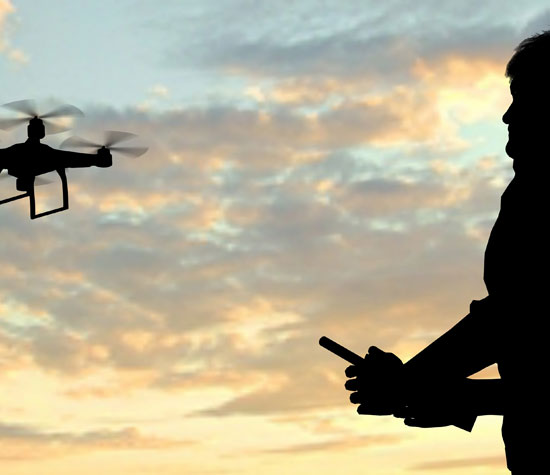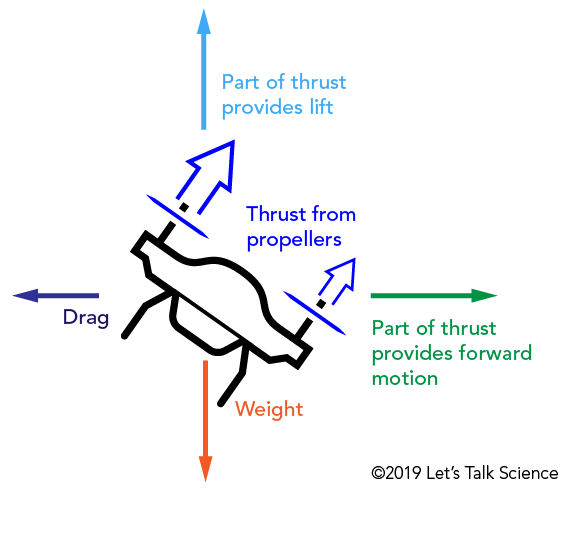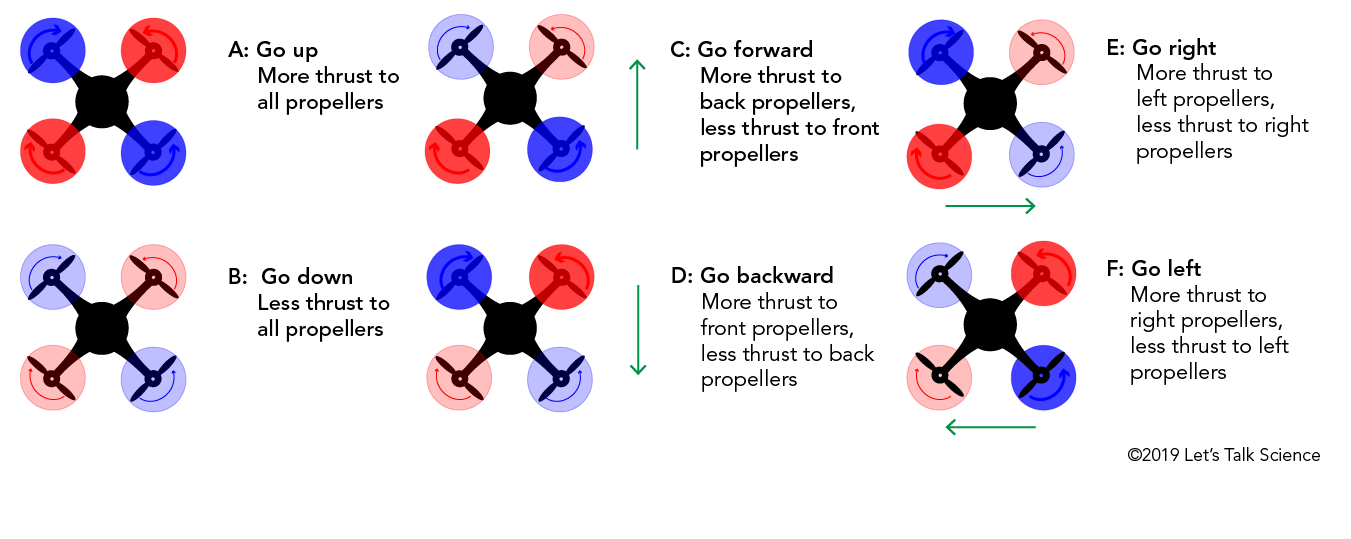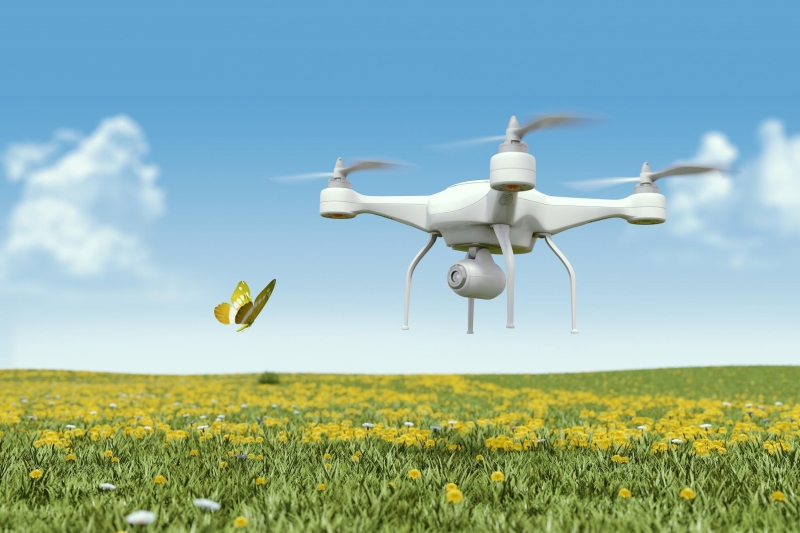It's a Bird, It's a Plane, It's... a Drone!

A man powers a drone with a remote control. Image © Bestgreenscreen, iStockphoto.com

A man powers a drone with a remote control. Image © Bestgreenscreen, iStockphoto.com
How does this align with my curriculum?
Drones are very cool and very useful aircraft! This resource explains how drones stay in flight, and outlines some of their uses.
Flying robots were once the stuff of science fiction. Today, they’re pretty common. Drones aren’t just cool.They’re also very useful! People have used drones for military activities. Scientists have used drones for research. Drones were even used in the 2017 Superbowl halftime show!
Let’s look at how drones work. Then, let’s look at a few of the fascinating ways people use them.
What is a drone?
Drones are aircraft that can move without a human on board. Many drones look sort of like little helicopters. Helicopters have one or two sets of propellers. But drones have multiple propellers. Some drones have four propellers. Other drones have six or more propellers. The size of the drone depends on what it’s being used for.
How do drones work?
The multiple propellers help the drone stay in flight for so long. They give the drone lift.

If one propeller fails, the drone usually has at least three others for backup.
The drone has no pilot on board, so it needs a controller. That controller could be a tablet computer, a smartphone, or a remote control like you would use for a toy car. The controller uses radio waves to communicate with each propeller. It tells them what to do so the drone may hover, fly forward, climb, or turn.
A drone does not have wings, so it has to use the thrust from its propellers to generate lift to stay in the air. It also has to use thrust to move the drone through the air. When airplanes are in the air, air flows over the control surfaces on their wings and tails. Airplanes use this air flow to change altitude, direction, and velocity. A drone does not have wings or control surfaces. It has to change the thrust from each of its engines to change altitude, direction, and velocity.

Many drones include a GPS and an altimeter. The GPS gives the drone’s location. The altimeter determines the drone’s height above the ground.
Drones can’t fly for very long. Typically, drones can fly for about 10 minutes. Then, they need a recharge. If drones had extra battery power, they would be heavier. If they were heavier, they wouldn’t be able to fly as well as they do.
How do people use drones in science?
Drones have had a bit of a bad reputation. Some people think that the military uses drones to spy on people and launch attacks.
Did you know?
The military also calls drones UAVs. This stands for unmanned or uninhabited aerial vehicles.
But drones don’t quite deserve that reputation. There’s a lot of amazing drone research happening. And drones are useful in many ways!
For example, drones may one day do the work of bees! Between 2006 and 2008, bee populations were much lower than usual. This gave the world quite a scare. Without bees, many of the food crops people rely on for survival will not grow. If that happened, people might have to pollinate flowers themselves!
What can people do to prepare for this situation? Well, scientists in Japan are trying to design little drones that can pollinate. Bees pollinate by carrying pollen from flower to flower. Scientists are trying to simulate this by adding a sticky gel to the surface of these drones. If this works, drones could help farmers pollinate their crops.

Scientists are also using drones to monitor different animal populations from a safe distance. This is a great way to study animals and their behaviours from far away. Without drones, scientists would have to climb up high and monitor birds themselves. They would also need large aircraft to perform aerial surveys of large areas. This can be very expensive.
Did you know?
Elmer Sperry designed a pilotless plane in 1917. He also invented autopilot technology and the gyroscope.
The technology has some limitations, though. Some animals are stressed when drones are around. Also, drones don’t fare well in more extreme conditions. For example, drones don’t do well in the Antarctic.
How are drones used in popular culture?
It’s not just science. Drones are showing up in popular culture, too. The 2017 Superbowl LI halftime show featured a drone swarm. As Lady Gaga sang on stage, a large number of drones formed shapes in the sky. They formed company logos and the American flag. How large a number? 300, to be exact. And the really amazing thing? All 300 drones were controlled by a single computer! This takes a huge amount of coordination. Each drone needs to know where the others are so they don’t crash into each other.
Would you like a drone of your own?
Do you think drones sound cool? If so, pick one up for yourself! Many electronics stores sell them. But be careful where you fly them. Do you live near an airport or airfield? If you do, remember that drones may interfere with commercial or private planes.
Also, a lot of countries restrict where you can fly drones. They also restrict how high you can fly drones. In Europe, the limit is 150m limit. In the United States, the limit is 120m.
What are some ways you can use drones yourself?
Starting Points
- Do you own a drone? Why did you get one? What do you do with it?
- Have you seen a drone flying before? What did you think about it?
- Other than the items mentioned in the article, what uses do you think drones could have?
- How are drones being used to help the environment?
- Are there any careers where drones may eliminate the need for human workers? What new careers have developed because of the introduction and application of drones?
- What restrictions for flying drones do we have in Canada? (Note: This question will require additional research.)
- How does a drone fly? Why do most drones have multiple propellers?
- Why is GPS integrated into most drones?
- What are the advantages of using drones for certain tasks? What are the disadvantages?
- How could drones change the way science is conducted (e.g., making observations, data collection, quantity of data collects, etc.)?
- Some drones can fly autonomously (without any human control). What are some issues that autonomous drones raise?
- What media have you seen that included drones? What was the drone doing in the piece? Was the media talking about a positive impact of drones or a negative impact?
- This article can be used for Grade 6 Science to support teaching and learning related to flight. Concepts introduced include drones, aircraft, lift, radio waves and populations.
- After reading this article, teachers could have students do a Concept Definition Map learning strategy to consolidate their understanding of drones. Ready-to-use Concept Definition Map reproducibles are available in [Google doc] and [PDF] formats.
- To consider the positive and negative aspects of drones, teachers could have students do a Pros & Cons Organizer learning strategy. Ready -to-use Pros & Cons Organizer reproducibles are available in [Google doc] and [PDF] formats.
- For a hands on design and build learning experience, students could attempt to make their own drones and test how they fly. This video demonstrates How to make a drone at home.
Connecting and Relating
- Do you own a drone? Why did you get one? What do you do with it?
- Have you seen a drone flying before? What did you think about it?
- Other than the items mentioned in the article, what uses do you think drones could have?
Relating Science and Technology to Society and the Environment
- How are drones being used to help the environment?
- Are there any careers where drones may eliminate the need for human workers? What new careers have developed because of the introduction and application of drones?
- What restrictions for flying drones do we have in Canada? (Note: This question will require additional research.)
Exploring Concepts
- How does a drone fly? Why do most drones have multiple propellers?
- Why is GPS integrated into most drones?
- What are the advantages of using drones for certain tasks? What are the disadvantages?
Nature of Science/Nature of Technology
- How could drones change the way science is conducted (e.g., making observations, data collection, quantity of data collects, etc.)?
- Some drones can fly autonomously (without any human control). What are some issues that autonomous drones raise?
Media Literacy
- What media have you seen that included drones? What was the drone doing in the piece? Was the media talking about a positive impact of drones or a negative impact?
Teaching Suggestions
- This article can be used for Grade 6 Science to support teaching and learning related to flight. Concepts introduced include drones, aircraft, lift, radio waves and populations.
- After reading this article, teachers could have students do a Concept Definition Map learning strategy to consolidate their understanding of drones. Ready-to-use Concept Definition Map reproducibles are available in [Google doc] and [PDF] formats.
- To consider the positive and negative aspects of drones, teachers could have students do a Pros & Cons Organizer learning strategy. Ready -to-use Pros & Cons Organizer reproducibles are available in [Google doc] and [PDF] formats.
- For a hands on design and build learning experience, students could attempt to make their own drones and test how they fly. This video demonstrates How to make a drone at home.
Learn more
Drones are setting their sights on wildlife (2017)
Article for Popular Science by Kate Baggaley, explaining how scientists are using drones to collect information about wildlife.
Lady Gaga’s halftime drones are a sign of the coming swarm (2017)
Article for Popular Science by Kelsey D. Atherton explaining the use of drones by singer Lady Gaga to create visual images.
Materially Engineered Artificial Pollinators (2017)
Paper by Svetlana A. Chechetka, Yue Yu, Masayoshi Tange, and Eijiro Miyako explaining how drone technology could be used to help pollinate plants.
This Is How Drones Work (2015)
Article by John P. Pullen for TIME Magazine explaining how drones work.
References
Chechetka, S., Yu, Y., Tange, M., & Miyako, E. (2017). Materially Engineered Artificial Pollinators. Chem, 2(2), 224-239. DOI: 10.1016/j.chempr.2017.01.008
Pearson, L. (n.d.). Developing the flying bomb. Naval History and Heritage Command.